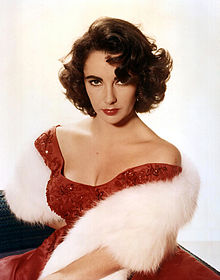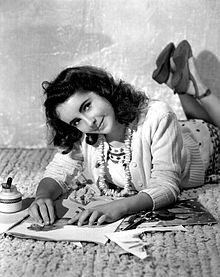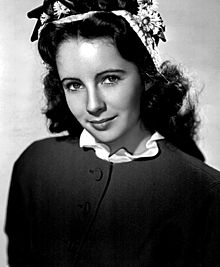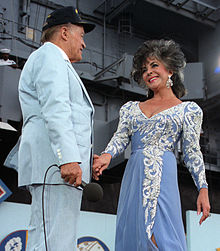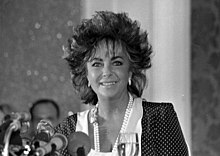Elizabeth Taylor
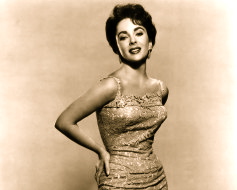
Elizabeth Taylor – True Hollywood Story (Documentary)
Dame Elizabeth Rosemond “Liz” Taylor, DBE (born February 27, 1932 — died March 23, 2011) was a British-American actress. From her early years as a child star with MGM, she became one of the great screen actresses of Hollywood’s Golden Age. As one of the world’s most famous film stars, Taylor was recognized for her acting ability and for her glamorous lifestyle, beauty, and distinctive violet eyes. National Velvet (1944) was Taylor’s first success, and she starred in Father of the Bride (1950), A Place in the Sun (1951), Giant (1956), Cat on a Hot Tin Roof (1958), and Suddenly, Last Summer (1959). She won the Academy Award for Best Actress for BUtterfield 8 (1960), played the title role in Cleopatra (1963), and married her co-star Richard Burton. They appeared together in 11 films, including Who’s Afraid of Virginia Woolf? (1966), for which Taylor won a second Academy Award. From the mid-1970s, she appeared less frequently in film, and made occasional appearances in television and theatre. Her much-publicized personal life included eight marriages and several life-threatening illnesses. From the mid-1980s, Taylor championed HIV and AIDS programs; she co-founded the American Foundation for AIDS Research in 1985, and the Elizabeth Taylor AIDS Foundation in 1993. She received the Presidential Citizens Medal, the Legion of Honor, the Jean Hersholt Humanitarian Award and a Life Achievement Award from the American Film Institute, who named her seventh on their list of the “Greatest American Screen Legends.” Taylor died of congestive heart failure in March 2011 at the age of 79, having suffered many years of ill health.
Dame Elizabeth Rosemond “Liz” Taylor, DBE (born February 27, 1932 – died March 23, 2011) was a British-American actress. From her early years as a child star with MGM, she became one of the great screen actresses of Hollywood’s Golden Age. As one of the world’s most famous film stars, Taylor was recognized for her acting ability and for her glamorous lifestyle, beauty, and distinctive violet eyes.
National Velvet (1944) was Taylor’s first success, and she starred in Father of the Bride (1950), A Place in the Sun (1951), Giant (1956), Cat on a Hot Tin Roof (1958), and Suddenly, Last Summer (1959). She won the Academy Award for Best Actress for BUtterfield 8 (1960), played the title role in Cleopatra (1963), and married her costarRichard Burton. They appeared together in 11 films, including Who’s Afraid of Virginia Woolf? (1966), for which Taylor won a second Academy Award. From the mid-1970s, she appeared less frequently in film, and made occasional appearances in television and theatre.
Her much-publicized personal life included eight marriages and several life-threatening illnesses. From the mid-1980’s, Taylor championed HIV and AIDS programs; she co-founded the American Foundation for AIDS Research in 1985, and the Elizabeth Taylor AIDS Foundation in 1993. She received the Presidential Citizens Medal, theLegion of Honour, the Jean Hersholt Humanitarian Award and a Life Achievement Award from the American Film Institute, who named her seventh on their list of the” Greatest American Screen Legends.” Taylor died of congestive heart failure in March 2011 at the age of 79, having suffered many years of ill health.
Early Life
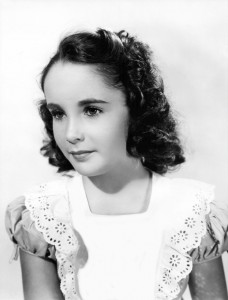 Elizabeth Rosemond Taylor was born at Heathwood, her parents’ home at 8 Wildwood Road in Hampstead Garden Suburb, a northwestern suburb of London; the younger of two children of Francis Lenn Taylor (1897–1968) and Sara Sothern (née Sara Viola Warmbrodt; 1895–1994), who were Americans residing in England. Taylor’s older brother, Howard Taylor, was born in 1929. Her parents were originally from Arkansas City, Kansas. Francis Taylor was an art dealer, and Sara was a former actress whose stage name was “Sara Sothern”. Sothern retired from the stage in 1926 when she married Francis in New York City. Taylor’s two first names are in honor of her paternal grandmother, Elizabeth Mary (Rosemond) Taylor. One of her maternal great-grandfathers was Swiss.
Elizabeth Rosemond Taylor was born at Heathwood, her parents’ home at 8 Wildwood Road in Hampstead Garden Suburb, a northwestern suburb of London; the younger of two children of Francis Lenn Taylor (1897–1968) and Sara Sothern (née Sara Viola Warmbrodt; 1895–1994), who were Americans residing in England. Taylor’s older brother, Howard Taylor, was born in 1929. Her parents were originally from Arkansas City, Kansas. Francis Taylor was an art dealer, and Sara was a former actress whose stage name was “Sara Sothern”. Sothern retired from the stage in 1926 when she married Francis in New York City. Taylor’s two first names are in honor of her paternal grandmother, Elizabeth Mary (Rosemond) Taylor. One of her maternal great-grandfathers was Swiss.
Colonel Victor Cazalet, one of their closest friends, had an important influence on the family. He was a rich, well-connected bachelor, a Member of Parliament and close friend of Winston Churchill. Cazalet loved both art and theatre and was passionate when encouraging the Taylor family to think of England as their permanent home. Additionally, as a Christian Scientist and lay preacher, his links with the family were spiritual. He also became Elizabeth’s godfather. In one instance, when she was suffering with a severe infection as a child, she was kept in her bed for weeks. She “begged” for his company: “Mother, please call Victor and ask him to come and sit with me.”
Biographer Alexander Walker suggests that Elizabeth’s conversion to Judaism at the age of 27 and her lifelong support for Israel, may have been influenced by views she heard at home. Walker notes that Cazalet actively campaigned for a Jewish homeland, and her mother also worked in various charities, which included sponsoring fundraisers for Zionism. Her mother recalls the influence that Cazalet had on Elizabeth:
“Victor sat on the bed and held Elizabeth in his arms and talked to her about God. Her great dark eyes searched his face, drinking in every word, believing and understanding.”
A dual citizen of the United Kingdom and the United States, she was born British through her birth on British soil and an American citizen through her parents. In October 1965, as her then-husband was British, she signed an oath of renunciation at the U.S. Embassy in Paris, but with the phrase “abjure all allegiance and fidelity to the United States” struck out. U.S. State Department officials declared that her renunciation was invalid due to the alteration and Taylor signed another oath, this time without alteration, in October 1966. She applied for restoration of U.S. citizenship in 1977, during then-husband John Warner‘s Senate campaign, stating she planned to remain in America for the rest of her life.
At the age of three, Taylor began taking ballet lessons. Shortly before the beginning of World War II, her parents decided to return to the United States to avoid hostilities. Her mother took the children first, arriving in New York in April 1939, while her father remained in London to wrap up matters in his art business, arriving in November. They settled in Los Angeles, California, where her father established a new art gallery, which included many paintings he shipped from England. The gallery soon attracted numerous Hollywood celebrities who appreciated its modern European paintings. According to Walker, the gallery “opened many doors for the Taylors, leading them directly into the society of money and prestige” within Hollywood’s movie colony.
Acting Career – Child Actress
Soon after settling in Los Angeles, Taylor’s mother discovered that Hollywood people “habitually saw a movie future for every pretty face”. Some of her mother’s friends, and even total strangers, urged her to have Taylor screen-tested for the role of Bonnie Blue, Scarlett‘s child in Gone with the Wind, then being filmed. Her mother refused the idea, as a child actress in film was alien to her, and in any case they would return to England after the war.
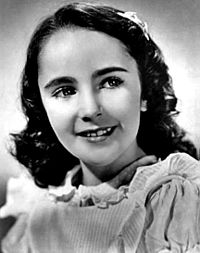 As a child actress, circa 1940
As a child actress, circa 1940
Hollywood columnist Hedda Hopper introduced the Taylors to Andrea Berens, the fiancée of John Cheever Cowdin, chairman and major stockholder of Universal Pictures. Berens insisted that Sara take Taylor to see Cowdin who, she assured, would be dazzled by her breathtaking beauty. Metro-Goldwyn-Mayer also became interested in Taylor, and MGM head Louis B. Mayer reportedly told his producer, “Sign her up, sign her up! What are you waiting for?” As a result, she soon had both Universal and MGM willing to place her under contract. When Universal learned that MGM was equally interested, however, Cowdin telephoned Universal from New York: “Sign her up, he ordered, don’t even wait for the screen test.” Universal then gave her a seven-year contract.
Taylor appeared in her first motion picture at the age of nine in There’s One Born Every Minute (1942), her only film for Universal.
After less than a year, however, the studio fired Taylor for unknown reasons. Some speculate that she did not live up to Cowdin’s promise. Walker believes that Taylor’s intuition told her “she wasn’t really welcome at Universal.” She learned, for instance, that her casting director complained, “The kid has nothing”, after a test. Even her beautiful eyes did not impress him. Taylor’s eyes were a deep blue that appeared violet and stunned those who met her in person, with a mutation that gave Taylor double eyelashes “Her eyes are too old, she doesn’t have the face of a child,” he said. But Walker admits that “this was not so far off the mark as it may appear now.” He explains:
“There was something slightly odd about Elizabeth’s looks, even at this age – an expression that sometimes made people think she was older than she was. She already had her mother’s air of concentration. Later on, it would prove an invaluable asset. At the time, it disconcerted people who compared her unfavorably with Shirley Temple‘s cute bubbling innocence or Judy Garland‘s plainer and more vulnerable juvenile appeal.?
Taylor herself remembers that when she was a child in England, adults used to describe her as having an “old soul,” because, as she says, “I was totally direct.” She also recognized similar traits in her baby daughter:
I saw my daughter as a baby, before she was a year old, look at people, steadily, with those eyes of hers, and see people start to fidget, and drop things out of their pockets and finally, unable to stand the heat, get out of the room.
Taylor’s father served as an air raid warden with MGM producer Sam Marx, and learned that the studio was searching for an English actress for a Lassie film. Taylor received the role and was offered a long-term contract at the beginning of 1943. She chose MGM because “the people there had been nicer to her when she went to audition,” Taylor recalled. MGM’s production chief, Benny Thau, was to remain the “only MGM executive” she fully trusted during subsequent years, because, writes Walker, “he had, out of kindly habit, made the gesture that showed her she was loved.” Thau remembered her as a “little dark-haired beauty … [with] those strange and lovely eyes that gave the face its central focus, oddly powerful in someone so young.” MGM, in addition, was considered a “glamorous studio”, boasting that it had “more stars than there are in heaven.” Before Taylor’s mother would sign the contract, however, she sought certainty that Taylor had a “God-given talent” to become an actress. Walker describes how they came to a decision:
[Mrs. Taylor] wanted a final sign of revelation … Was there a divine plan for her? Mrs. Taylor took her old script forThe Fool, in which she had played the scene of the girl whose faith is answered by a miracle cure. Now she asked Elizabeth to read her own part, while she read the lines of the leading man. She confessed to weeping openly. She said, ‘There sat my daughter playing perfectly the part of the child as I, a grown woman, had tried to do it. It seemed that she must have been in my head all those years I was acting.’
Adolescent star
MGM cast Taylor in Lassie Come Home (1943) with child-star Roddy McDowall, with whom she would share a lifelong friendship. He later recalled regarding her beauty, “who has double eyelashes except a girl who was absolutely born to be on the big screen?” The film received favorable attention for both actors, and MGM signed Taylor to a conventional seven-year contract, starting at $100 a week with regular raises. Her first assignment under her new contract was a loan-out to 20th Century Fox for the character of Helen Burns in a film version of the Charlotte Brontë novel Jane Eyre (1943). Taylor returned to England to appear in another McDowall picture for MGM, The White Cliffs of Dover (1944).
Taylor’s persistence in seeking the role of Velvet Brown in MGM’s National Velvet made her a star at the age of 12. Her character was a young girl, training her beloved horse to win the Grand National. Velvet, which costarred fellow young actor Mickey Rooney and English newcomer Angela Lansbury, became a great success upon its release in December 1944. Many years later Taylor called it “the most exciting film” she had ever made, although the film caused many of her later back problems due to her falling off a horse during filming.
 Viewers and critics “fell in love with Elizabeth Taylor when they saw her in it.” Walker explains why the film was popular:
Viewers and critics “fell in love with Elizabeth Taylor when they saw her in it.” Walker explains why the film was popular:
“Its enormous popularity rubs off on to its heroine because she expresses, with the strength of an obsession, the aspirations of people—people who have never seen a girl on horseback, or maybe even a horse race for that matter—who believe that anything is possible … A philosophy of life, in other words … a film which … has acquired the status of a generational classic …”
National Velvet grossed over US$4 million and MGM signed Taylor to a new long-term contract. Because of the movie’s success she was cast in another animal film, Courage of Lassie (1946), in which Bill the dog outsmarts the Nazis. The film’s success led to another contract for Taylor paying her $750 per week. Her roles as the neurotic Mary Skinner in a loan-out to Warner Brothers‘ Life With Father (1947), Cynthia Bishop in Cynthia(1947), Carol Pringle in A Date with Judy (1948), and Susan Prackett in Julia Misbehaves (1948) were all successful. Taylor received a reputation as a consistently successful adolescent actress, with a nickname of “One-Shot Liz” (referring to her ability to shoot a scene in one take) and a promising career. Taylor’s portrayal of Amy in the American classic Little Women (1949) was her last adolescent role.
MGM studios provided schooling for its child stars with classrooms within the studio grounds. Taylor, however, came to dislike being cut off from typical schools with average students who were not treated like stars. She recalls her life before studio acting as a happier period in her childhood:
“One of the few times I’ve ever really been happy in my life was when I was a kid before I started acting. With the other kids I’d make up games, play with dolls, pretend games … As I got more famous—after National Velvet, when I was 12—I still wanted to be part of their lives, but I think in a way they began to regard me as a sort of an oddity, a freak.
I hated school—because it wasn’t school. I wanted terribly to be with kids. On the set the teacher would take me by my ear and lead me into the schoolhouse. I would be infuriated; I was 16 and they weren’t taking me seriously. Then after about 15 minutes I’d leave class to play a passionate love scene as Robert Taylor’s wife.”
Transition into Adult Roles
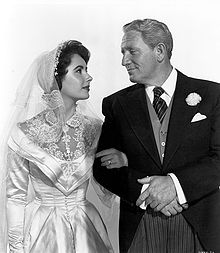 Taylor with Spencer Tracy in a promotional image for Father of the Bride (1950)
Taylor with Spencer Tracy in a promotional image for Father of the Bride (1950)
The teenage Taylor was reluctant to continue making films. Her stage mother forced Taylor to relentlessly practice until she could cry on cue and watched her during filming, signaling to change her delivery or a mistake. Taylor met few others her age on movie sets, and was so poorly-educated that she needed to use her fingers to do basic arithmetic. When, at age 16, Taylor told her parents that she wanted to quit acting for a normal childhood, Sara Taylor told her that she was ungrateful: “You have a responsibility, Elizabeth. Not just to this family, but to the country now, the whole world.”
In October 1948, Taylor sailed aboard the RMS Queen Mary to England to begin filming Conspirator. Unlike some other child actors, Taylor made an easy transition to adult roles. Before Conspirator‘s 1949 release, a TIME cover article called her “a jewel of great price, a true star sapphire”, and the leader among Hollywood’s next generation of stars such as Montgomery Clift, Kirk Douglas, and Ava Gardner. The petite Taylor had the figure of a mature woman, with a 19″ waist. Conspirator failed at the box office, but 16-year-old Taylor’s portrayal of a 21-year-old debutante who unknowingly marries a communist spy played by 38-year-old Robert Taylor, was praised by critics for her first adult lead in a film. Taylor’s first picture under her new salary of $2,000 per week was The Big Hangover (1950), both a critical and box office failure, that paired her with screen idol Van Johnson. The picture also failed to present Taylor with an opportunity to exhibit her newly realized sensuality.
Her first box office success in an adult role came as Kay Banks in the comedy Father of the Bride (1950), alongside Spencer Tracy and Joan Bennett. The film spawned a sequel, Father’s Little Dividend (1951), which Taylor’s costar Spencer Tracy summarized with “boring … boring … boring.” The film did well at the box office, but it would be Taylor’s next picture that would set the course for her career as a dramatic actress.
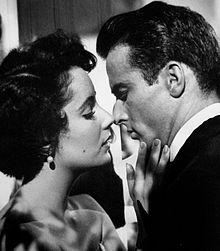 With Montgomery Clift in A Place in the Sun (1951)
With Montgomery Clift in A Place in the Sun (1951)
In late 1949, Taylor had begun filming George Stevens‘ A Place in the Sun. Upon its release in 1951, Taylor was hailed for her performance as Angela Vickers, a spoiled socialite who comes between George Eastman (Montgomery Clift) and his poor, pregnant factory-working girlfriend Alice Tripp (Shelley Winters). The film, based on Theodore Dreiser‘s novel, An American Tragedy, was an indictment of “the American dream” and its corrupting influences, notes biographer Kitty Kelley. Although Taylor, then only 17, was unaware of the psychological implications of the story and its powerful nuances, it became the pivotal performance of Taylor’s career. Kelley explains that Stevens, its director, knew that with Elizabeth Taylor as the young and beautiful star, the “audience would understand why George Eastman (Clift) would kill for a place in the sun with her.” Hollywood columnist Hedda Hopper, allowed on the set to watch the filming, became “wide-eyed watching the little girl from National Velvetseduce Montgomery Clift in front of the camera,” writes Kelley. When the scene was over, Hopper went to her, “Elizabeth, where on earth did you ever learn how to make love like that?”
Critics acclaimed the film as a classic, a reputation it sustained throughout the next 50 years of cinema history. The New York Times‘ A.H. Weiler wrote, “Elizabeth’s delineation of the rich and beauteous Angela is the top effort of her career,” and the Boxoffice reviewer unequivocally stated “Miss Taylor deserves an Academy Award.”
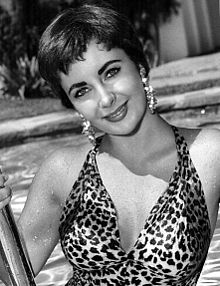 In The Last Time I Saw Paris (1954)
In The Last Time I Saw Paris (1954)
Taylor became increasingly unsatisfied with the roles being offered to her at the time. While she wanted to play the lead roles in The Barefoot Contessa and I’ll Cry Tomorrow, MGM continued to restrict her to mindless and somewhat forgettable films such as: a cameo as herself in Callaway Went Thataway (1951), Love Is Better Than Ever (1952),Ivanhoe (1952), and The Girl Who Had Everything (1953).
Taylor’s next screen endeavor, Rhapsody (1954), another tedious romantic drama, proved equally frustrating. Taylor portrayed Louise Durant, a beautiful rich girl in love with a temperamental violinist (Vittorio Gassman) and an earnest young pianist (John Ericson). A film critic for the New York Herald Tribune wrote: “There is beauty in the picture all right, with Miss Taylor glowing into the camera from every angle … but the dramatic pretenses are weak, despite the lofty sentences and handsome manikin poses.”
Taylor’s fourth period picture, Beau Brummell, made just after Elephant Walk andRhapsody, cast her as the elaborately costumed Lady Patricia, which many felt was only a screen prop—a ravishing beauty whose sole purpose was to lend romantic support to the film’s title star, Stewart Granger.The Last Time I Saw Paris (1954) fared only slightly better than her previous pictures, with Taylor being reunited with The Big Hangover costar Van Johnson. The role of Helen Ellsworth Willis was based on that of Zelda Fitzgerald and, although pregnant with her second child, Taylor went ahead with the film, her fourth in 12 months. Although proving somewhat successful at the box office, she still yearned for more substantial roles.
1955–79
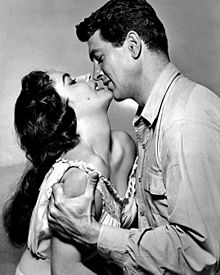 With Rock Hudson in Giant (1956)
With Rock Hudson in Giant (1956)
Following a more substantial role opposite Rock Hudson and James Dean in George Stevens‘ epic Giant (1956), Taylor was nominated for an Academy Award for Best Actress four years in a row for Raintree County (1957) opposite Montgomery Clift; Cat on a Hot Tin Roof (1958) opposite Paul Newman; Suddenly, Last Summer (1959) with Montgomery Clift, Katharine Hepburn and Mercedes McCambridge; and finally winning for BUtterfield 8 (1960). The film co-starred then-husband Eddie Fisher and ended her contract, which Taylor said had made her an “MGM chattel” for 18 years. Suddenly, Last Summer’s success placed Taylor among the top-ten most successful actors at the box office, and she remained in the top-ten almost every year for the next decade. In 1960, Taylor became the highest-paid actress up to that time when she signed a $1 million dollar contract to play the title role in 20th Century Fox‘s lavish production of Cleopatra, which was released in 1963. During the filming, she began a romance with her future husband Richard Burton, who played Mark Antony in the film. The romance received much attention from the tabloid press, as both were married to other spouses at the time. Taylor ultimately received $7 million for her role.
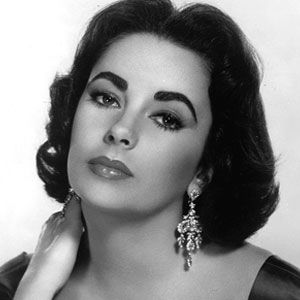 Her second Academy Award, also for Best Actress in a Leading Role, was for her performance as Martha in Who’s Afraid of Virginia Woolf? (1966), playing opposite then-husband Richard Burton. The film was a turning point for both Taylor and Burton, as it was the “most exciting and daunting project either of them had ever contemplated,” writes Walker. Taylor saw the film as her chance to act, “to reallyact,” and a chance to emulate one of her favorite dramatic actresses, Vivien Leigh, who played roles as a “tragic heroine.” For this part, however, Taylor worried that she did not look old enough, as her character was to be twenty years older. To compensate, she added gray hairs and transformed herself both physically and vocally: she intentionally gained weight, minimized makeup, and added excessive mascara to her eyes along with smudgy bags beneath them.
Her second Academy Award, also for Best Actress in a Leading Role, was for her performance as Martha in Who’s Afraid of Virginia Woolf? (1966), playing opposite then-husband Richard Burton. The film was a turning point for both Taylor and Burton, as it was the “most exciting and daunting project either of them had ever contemplated,” writes Walker. Taylor saw the film as her chance to act, “to reallyact,” and a chance to emulate one of her favorite dramatic actresses, Vivien Leigh, who played roles as a “tragic heroine.” For this part, however, Taylor worried that she did not look old enough, as her character was to be twenty years older. To compensate, she added gray hairs and transformed herself both physically and vocally: she intentionally gained weight, minimized makeup, and added excessive mascara to her eyes along with smudgy bags beneath them.
Taylor and Burton appeared together in six other films during the decade, among them The V.I.P.s (1963), The Sandpiper (1965), and The Taming of the Shrew (1967). By 1967 their films had earned $200 million at the box office. When Taylor and Burton considered not working for three months, the possibility caused alarm in Hollywood as “nearly half of the U.S. film industry’s income” came from movies starring one or both of them. Their next films Doctor Faustus (1967), The Comedians (1967) and Boom! (1968), however, all failed at the box office.
Taylor appeared in John Huston‘s Reflections in a Golden Eye (1967) opposite Marlon Brando (replacing Clift, who died before production began) and Secret Ceremony (1968) opposite Mia Farrow. By the end of the decade her box-office drawing power had considerably diminished, as evidenced by the failure of The Only Game in Town (1970), with Warren Beatty.
Although limited by a “thin and inflexible voice,” Taylor continued to star in numerous theatrical films throughout the 1970’s, such as Zee and Co. (1972) with Michael Caine, Ash Wednesday (1973), The Blue Bird (1976) with Jane Fonda and Ava Gardner, and A Little Night Music (1977). With then-husband Richard Burton, she co-starred in the 1972 films Under Milk Wood and Hammersmith Is Out, and the 1973 made-for-TV movie Divorce His, Divorce Hers.
1980–2003
Taylor starred in the 1980 mystery film The Mirror Crack’d, based on an Agatha Christie novel. In 1985, she played movie gossip columnist Louella Parsons in the TV film Malice in Wonderland opposite Jane Alexander, who played Hedda Hopper. Taylor appeared in the miniseries North and South as well as playing the titular role in a 1987 Western TV-movie entitled Poker Alice with Tom Skerritt and George Hamilton. Her last theatrical film was 1994’s The Flintstones.
At the American Film Festival in Deauville, 1985
In February 1996, she appeared on the TV program, The Nanny as herself, and the star of the show, Fran, identified her to a friend by using all of her husbands’ names, stating that she would be meeting “Elizabeth Taylor-Hilton-Wilding-Todd-Fisher-Burton-Burton-Warner-Fortensky”. In 2001 she played an agent in the TV film These Old Broads. She appeared on a number of television series, including the soap operas General Hospitaland All My Children, as well as the animated series The Simpsons—once as herself, and once as the voice of Maggie Simpson, uttering one word, “Daddy.”
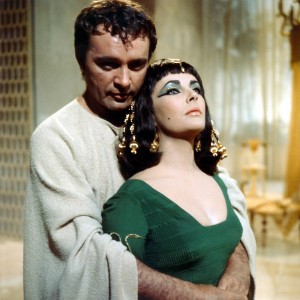 Taylor also acted on the stage, making her Broadway and West End debuts in 1982 with a revival of Lillian Hellman‘s The Little Foxes. She was then in a production of Noël Coward‘s Private Lives (1983), in which she starred with her former husband, Richard Burton. The student-run Burton Taylor Studio in Oxford was named for the famous couple after Burton appeared as Doctor Faustus in the Oxford University Dramatic Society (OUDS) production of the Marlowe play. Taylor played the ghostly, wordless Helen of Troy, who is entreated by Faustus to “make [him] immortal with a kiss.”
Taylor also acted on the stage, making her Broadway and West End debuts in 1982 with a revival of Lillian Hellman‘s The Little Foxes. She was then in a production of Noël Coward‘s Private Lives (1983), in which she starred with her former husband, Richard Burton. The student-run Burton Taylor Studio in Oxford was named for the famous couple after Burton appeared as Doctor Faustus in the Oxford University Dramatic Society (OUDS) production of the Marlowe play. Taylor played the ghostly, wordless Helen of Troy, who is entreated by Faustus to “make [him] immortal with a kiss.”
In the early 1980’s, Taylor moved to Bel Air, Los Angeles, which was her residence until her death. She also owned homes in Palm Springs, London and Hawaii.

